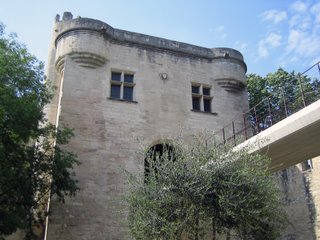 Une gargouille agrippée à la flèche de la très belle église Saint Pierre. Celle-ci aurait été maintes fois reconstruite, faisant remonter au VIIe siècle la première construction, on raconte en effet qu'elle aurait abrité les tombeaux des premiers évêques de la ville. Celle qu'on peut découvrir aujourd'hui date de l'an 1358, début des travaux tandis que le clocher est plus tardif, il fut édifié plus d'un siècle après, en 1495. Les "bêtes" sont toujours là veillants à rejeter l'eau de pluie et aussi à chasser tout être maléfique essayant d'aborder l'antre sacré. On rencontre de nombreuses gargouilles sur les édifices gothiques à travers la France et les pays voisins peuplés de cathédrales.
Une gargouille agrippée à la flèche de la très belle église Saint Pierre. Celle-ci aurait été maintes fois reconstruite, faisant remonter au VIIe siècle la première construction, on raconte en effet qu'elle aurait abrité les tombeaux des premiers évêques de la ville. Celle qu'on peut découvrir aujourd'hui date de l'an 1358, début des travaux tandis que le clocher est plus tardif, il fut édifié plus d'un siècle après, en 1495. Les "bêtes" sont toujours là veillants à rejeter l'eau de pluie et aussi à chasser tout être maléfique essayant d'aborder l'antre sacré. On rencontre de nombreuses gargouilles sur les édifices gothiques à travers la France et les pays voisins peuplés de cathédrales.A gargoyle fixed to the arrow of the very beautiful church Saint Pierre. This one would have been rebuilt many times, the first construction were probably at the VII th century, we tells that it would have sheltered the tombs of the first bishops of the city. The one we can discover now date of the year 1358, beginning of work, while the bell-tower is later, built more than one century after, in 1495. These “animals” are always there taking care to reject rainwater and also to drive out any malefic's creature trying to approach this sacred place. We meets many gargoyle on Gothic's buildings through the France and the countries around populated of cathedrals.



























